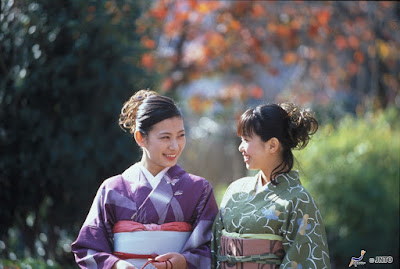The cherry blossoms in full bloom adorning the riverside
looked resplendent. The water sparkled in the sunlight. My idyllic day was
getting better moment by moment as suddenly, a white-faced geisha or a geiko as
they are known here, dressed in a traditional kimono, crossed in front of me.
 |
|
Weeping cherry
trees
©Kyoto Prefecture/©
JNTO
|
This was the romantic Japan that I had seen in films and
read about in books. Kyoto, the country’s capital for over 1,000 years, (the
role now taken by Tokyo) and the birthplace of the tea ceremony, beats to its own rhythm embracing
effortlessly the past and present.
Here temples, customs and culture rub shoulders with
technology, trendy restaurants, cafés and designer shops. Modern futuristic
buildings sit harmoniously with Shinto shrines, Buddhist temples, castles and
palaces.
 |
|
Yasaka Shrine
©JNTO
|
Nestled in a valley and surrounded by green mountains, Kyoto
has an appealing charm. People are friendly and it is an easy city to get
around as there are only two subway lines. So, if you get lost, all you need to
do is point on a map to your destination and somebody will help you even if
they do not speak English.
I arrived by the Tokaido Shinkansen (bullet train) from
Tokyo, which is an experience in itself. I was taken aback by how contemporary Kyoto
was. Starbucks and other familiar names that you would find on any high street
back home greeted me. Not a sign of one of the 1,600 or so Budhist temples or
400 Shinto shrines that would tell me a tale of Kyoto’s glorious yesteryears.
 |
|
Kyoto, Gion
©JNTO
|
But, as I started to explore I started to uncover the city’s
treasures such as the Kyoto Imperial Palace, nestled in the Imperial Palace
Park, the Kiyomizu-dera Temple renowned for the Kiyomizu-no-butai (main hall's
wooden veranda) which looks like it comes out of the mountain slope and the
Ryoan-ji Temple known for its Sekitei rock garden.
Rokuon-ji Temple, also called Kinkaku-ji or the Temple of
the Golden Pavilion, one of Japan’s most famed sights, surrounded by beautiful
gardens shimmered in the sunlight, the reflection captured in the surrounding
pond. This was a picture to be stored in the memory bank.
Fushimi Inari Taisha is impressive. This Shinto shrine,
renowned for its scarlet red tori (gates) that weave up the mountain behind it,
was dedicated, in the 8th century, to the gods of rice and sake by
the Hata family.
The Japanese are reputed to like harmony in all things and
wandering around you certainly feel a Zen-like calm. However, there are only so
many temples and shrines you can look at so it was time to have complete change
of scene and head to Nishiki Market, a long shopping street peppered with
shops, stalls and restaurants. This is a good place to go to sample Kyoto’s
excellent cuisine.
In Gion, the fabled geisha district, laced among the wooden
buildings are chic Japanese restaurants and ochayas (teahouses). Roaming around
the cobbled streets, I got a glimpse into another world. Oh, and fitted in just
one more shrine, the lauded Yasaka-jinja.
By Daralyn Danns
Getting there
Japan Airlines. For information about flights and fares
visit www.jal.com